El Niño's
Dramatic Impact on Ocean Biology,
|
|||||||||||||||||||||||||||||||||
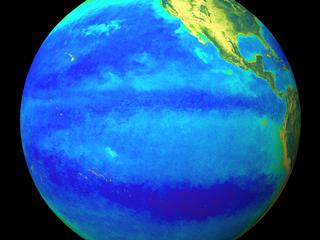 |
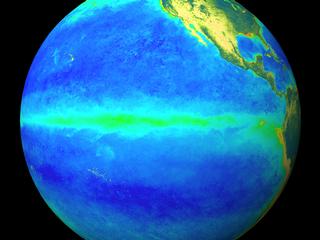 |
This sequence illustrates the vast size and intensity of the ocean's biological rebound from El Niño. Satellite imagery from NASA's Sea-viewing Wide-Field-of-view Sensor (SeaWiFS) instrument showed nearly a complete lack of plankton along the equatorial Pacific during El Niño. The cool waters associated with La Niña brought nutrients from the below the surface and enabled an enormous plankton bloom (shown in green).
View A Sequence of Weekly (Eight-day averages) Images from September 1997 to September 2000
View A Sequence of Monthly Images from September 1997 to June 1999
REBOUND FROM EL NIÑO
The SeaWiFS data revealed surprisingly low levels of plankton coinciding with El Niño's strongest phase. The cooler waters associated with La Niña brought a huge plankton bloom along the equator (shown in green).See the 22 month Movie Sequence (5.7 MB)
EXPLOSION IN THE GALAPAGOS

SeaWiFS documented the rapid demise of El Niño in the waters around the Galapagos Islands. The images show a explosion in plankton growth as the warm El Niño waters blamed for choking off essential ocean nutrients are replaced by deep cold upwelled waters. The false color images, which document plankton concentrations a period from May 9 - 24 1998, show that life in the region to the west archipelago has returned in remarkable abundance. High concentrations are shown red. Areas occluded by clouds are shown in white. View Image Above at Higher Resolutions
THE CARBON CONNECTION - PHYSICAL PROCESSES
By understanding the magnitude of the huge plankton bloom, scientists were able to calculate how changes in biologic activity caused massive changes in carbon dioxide. Scientists determined that El Niño cut the amount of carbon dioxide released into the atmosphere by 700 million metric tons. The deep ocean waters normally release large amounts of carbon dioxide. During El Niño, the carbon-dioxide-rich waters were held below the surface.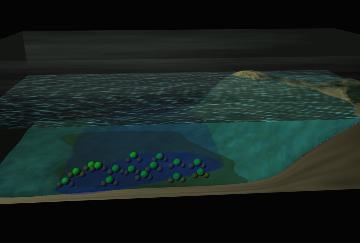 |
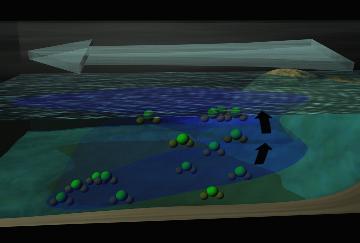 |
 |
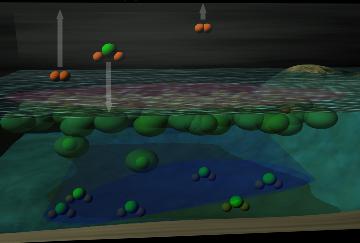 |
 |
THE CARBON CONNECTION - BIOLOGICAL PROCESSES
Nutrients in the cooler waters associated with La Niña were brought to the surface and helped fuel a huge plankton bloom. This animation shows how the tiny plants can lock up carbon when they die.THE 1997-98 EL NIÑO

The 1997-98 El Niño was truly a global event. The sequence shows a superposition of sea surface temperature anomalies on anomalies of the sea surface elevation. Warmer than normal temperatures are shown in red and cooler than normal temperatures are shown in blue. View Image Above at Higher Resolutions
3-D EL NIÑO
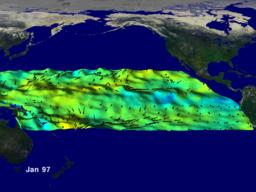 |
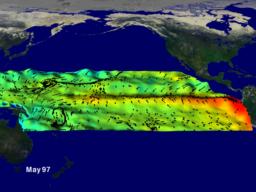 |
 |
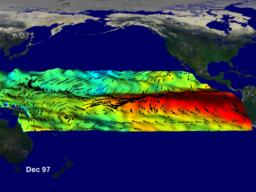 |
| Jan 1997 | May 1997 | Sep 1997 | Dec 1997 |
View Images Above at Higher Resolutions
PHYTOPLANKTON -- UP CLOSE AND PERSONAL
Images of phytoplankton and zooplankton. Plankton are lowest rungs on the oceanic food chain.BUOY ARRAY
Scientists also used data from the National Oceanic and Atmospheric Administration's Tropical Atmosphere Ocean array. Buoy Array MovieEYE IN THE SKY - SEAWIFS

NASA's Sea-viewing Wide Field-of-View Sensor (SeaWiFS) gave researchers an unprecedented view into the extreme biological effects of this El Niño/La Niña event
Movies |
||
|---|---|---|
| 12 Month Sequence | 22 Month Sequence | Areas of Interest |
| Pacific | Pacific | Toga Tao Buoys |
| Galapagos Islands | ||
| Carbon-Biological Processes(5.9 M) | ||
| Carbon-Physical Processes(4.0
M) | ||
Read More About The
SeaWifs Project
Read More About El Niño/La Niña
Credit line for all images:
NASA/Goddard Space Flight Center
The SeaWiFS Project and ORBIMAGE
Scientific Visualization Studio
NOTE: All SeaWiFS images and data presented on this website are for research and educational use only. All commercial use of SeaWiFS data must be coordinated with ORBIMAGE.